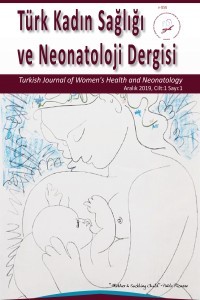Postmenapozal Hastalarda Trombosit Hacmi, Trombosit/Lenfosit ve Nötrofil/Lenfosit Oranlarının Vücut Kitle İndeksine Göre Karşılaştırılması ve Bu Sonuçların Kardiyovasküler Risk ve Sıcak Basması Üzerine Etkileri
Menopoz, inflamasyon, kardiyovasküler hastalıklar
Comparison of Thrombocyte Volume, Thrombocyte/Lymphocyte and Neutrophil/Lymphocyte Ratios According to Body Mass Index in Postmenopausal Patients and The Effect of These Results On Cardiovascular Risk and Hot Flashes
Menapause, inflammation, cardiovascular diseases,
___
- 1- Gezer A. Menopoz ve Osteoporoz, Kadın Hastalıkları ve Doğum Bilgisi Kitabı 1. bs, Güneş Kitabevi, Ofset Matbaacılık, Ankara ; 2004 .s. 1163-1165
- 2- Nathorst-Boos J, Schoultz B , Psychological Reactions and Sexual Life After Hysterectomy with and without Oophorectomy , Gynecol Obstet Invest . 1992; 34(2) : 97-101.
- 3- Steams V, Ullmer L, Lopez JF, Smith Y, Isaacs C, Hayes DF . Hot Flushes , Lancet 2002 ; 360: 1851-1861
- 4- Reddy Kilim S., RaoChandala S. A Comparativestudy of Lipid Profile Andoestradiol in pre- and post-Menopausal women. Journal of Clinicaland Diagnostic Research. 2013 ; 7(8):1596–1598
- 5- Varu D. M. S., Vegad D. A. M., Jani D. H. A., Savalia D. C. V., Joshi D. V. S. A Comparativestudy of Serum Lipid Profile Between Premenopausal and Postmenopausal Women. National Journal of Integrated Research in Medicine. 2012 ; 3(1):43–45
- 6- Deepthi S., Naidu J., Narayan A. R. Relationship Between Estrogen and Lipid Profile Status in Postmenopausal Women. International Journal of Applied Biology and Pharmaceutical Technology. 2012; 3(3 ): 230–234
- 7- Kumar S., Shah C. , Oommen ER. Study of Cardiovascular Risk Factors in Pre and Postmenopausal Women. International Journal of Pharma Sciences and Research. 2012;3(12):560–570
- 8- Manson JE. , Hsia J. , Johnson KC. et al. Estrogen Plus Progestin and The Risk of Coronary Heart Disease . The New England Journal of Medicine 2003 ; 349:523-534
- 9- Geroulakos G. , O’Gornam DJ. , Kalodiki E. et al. The Carotid Intima-Media Thickness as a Marker of the Presence of Severe Symptomatic Coronary Artery Disease. Eur Heart J 1994 ;15(6):781-5
- 10- Demircan S. , Tekin A. , Topcu S. ve ark. Comparison of Carotid Intima Media Thickness in Patients with Stabile Angina Pectoris Versus Patients with Acute Coronary Sendrome. Am J Cardiol 2005 ; 96(5):643-4
- 11- Gibson PH. , Cuthbertson BH. , Croal BL. et al. Usefulness of Neutrophil/Lymphocyte Ratio as Predictor of New-Onset Atrial Fibrillation After Coronary Artery Bypass Grafting. Am J Cardiol 2010 ; 105: 186-91
- 12- Li N. ; Platelet–Lymphocyte Cross-Talk. Journal of Leukocyte Biology, 2008 ; 83(5): 1069- 1078.
- 13- Murray CJL. , Lopez AD. Alternative Projections of Mortality and Disability by Cause 1990-2020: Global Burden of Disease Study Lancet 1997 ; 349: 1498-1504.
- 14- 4. World HealthOrganization. Reducing Risks, Promoting Healthy Life. The World Health Report 2002
- 15- Colina I. , Sunsundegui P ., Camarero B. , Núñez-Córdoba JM. , Beloqui Ó. Comparison of Correlations of Equation-Derived Body Fat Percentage and Body Mass Index with Carotid Intima-Media Thickness 2018 Acta Diabeto Lógica Landecho MF,
- 16- Zahorec R. Ratio of Neutrophil to Lymphocyte Counts—Rapid and Simple Parameter of Systemic Inflammation and Stress in Critically Ill. Bratisl LekListy 2001; 102:5-14
- 17- Y. Furuncuoğlu, S. Tulgar , A.N. Doğan , S. Çakar , Y.K. Tulgar , B. Çakıroğlu How Obesity Affects the Neutrophil/Lymphocyte and Platelet/Lymphocyte Ratio, Systemic Immune-Inflammatory Index and Platelet Indices Eur Rev Med Pharmacol Sci 2016 ; 20(7):1300-6
- 18- E. Erdal , M. İnanır Platelet to Lymphocyte Ratio (PLR) and Platelet Crit (PCT) in Young Patients with Morbid Obesit ; Rev Assoc Med Bras 1992 ; 65(9):1182-1187
- 19- Sharma K. , Patel A. , Shah K. , Konat A. Is Neutrophil-to-Lymphocyte Ratio a Predictor of Coronary Artery Disease in Western Indians? International Journal of Inflammation 2017 ; 2017(4) :1-8
- 20- Durmus E. , Kivrak T. , Gerin F. , Sunbul M. , Sari I., Erdogan O. Neutrophil to Lymphocyte Ratio and Platelet to Lymphocyte Ratio are Predictors of Heart Failure , Arq Bras Cardiol 2015; 105(6): 606–613
- 21- Seropian I. , Romeo F. , Pizarro R. et al. Neutrophil‐to‐Lymphocyte Ratio and Platelet‐to‐Lymphocyte Ratio as Predictors of Survival After Heart Transplantation , ESC Heart Fail 2018 ; 5(1):149-156
- 22- Koo S. , Ahn Y. , Lim J. et al. Obesity Associates with Vasomotor Symptoms in Postmenopause but with Physical Symptoms in Perimenopause , BMC Womens Health 2017 ; 17(1):126
- Başlangıç: 2019
- Yayıncı: Sağlık Bilimleri Üniversitesi Etlik Zübeyde Hanım Kadın Hastalıkları Eğitim ve Araştırma Hastanesi
Hüsniye YÜCEL, İstemi Han ÇELİK, Ayşen Sumru KAVURT, Beyza ÖZCAN, Semih SANDAL, Ahmet Yağmur BAŞ, Nihal DEMİREL
Tuğba KINAY, Şule ATALAY MERT, Caner KOSE, Sinan KARADENİZ, Yaprak USTUN
Sezaryen Doğumda Gelişmiş Cerrahi Sonrası İyileşme Programları: Literatür Taraması
Tuğba KINAY, Müjde Can İBANOĞLU, Yaprak USTUN
Koenzim Q10: Güncel Genel Bakış
Kadriye ERDOĞAN, Melahat Sedanur MACİT, Nazlı Tunca ŞANLIER, Yaprak USTUN
Rabia Merve PALALIOGLU, Halil İbrahim ERBIYIK
Duktus Venozus Agenezisinin Prenatal Tanısı: Olgu Serisi
Neval ÇAYÖNÜ KAHRAMAN, Ozge YUCEL CELİK, Cantekin İSKENDER
Mehmet Alican SAPMAZ, İlknur SAYAR, Ece YİĞİT, Tuncay KÜÇÜKÖZKAN
Okan OKTAR, Hande Esra KOCA, Candost HANEDAN, Caner KOSE, Fulya KAYIKÇIOĞLU, Caner ÇAKIR
